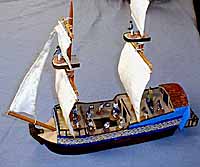 My 25mm pirates have grown weary of tavern fights. It was time for them to take the seas and do some real pirating. At Historicon I went in search of a simple set of rules for naval warfare in the age-of-sail. I ended up in a game of "Limeys and Slimeys" hosted by Derrick Watson and Lembit Tohver.
My 25mm pirates have grown weary of tavern fights. It was time for them to take the seas and do some real pirating. At Historicon I went in search of a simple set of rules for naval warfare in the age-of-sail. I ended up in a game of "Limeys and Slimeys" hosted by Derrick Watson and Lembit Tohver.
The scenario, called "Arrr, Me Buchohs," used some impressive sailing ships and 25mm figures. The players were divided into two teams of pirates. Each pirate team had a large flagship and three smaller ships. Each player controlled one ship. A massive merchant ship was the target of both teams. In addition, each player was given an additional secret objective. After five minutes of instruction the fight began.
I was sailing the small lead ship and immediately made the mistake of moving too far ahead of my teammates. I blundered on my third move and left myself out of firing position. An enemy ship maneuvered properly and blasted me with grapeshot. On the following turn a bad die roll left my opponents with the initiative. Two more whiffs of grapeshot and my entire crew was wiped out. After just half an hour of play I was out of the game.
Although my one experience with the rules was a bitter disappointment there is much to recommend. There are two things that I hate in naval rules: pre-plotting and recording your movement (and ammunition loads), and critical hits. Limeys and Slimeys has neither of these things. The rules are so simple that they fit on one sheet of paper (double sided).
Movement
An initiative die roll determines which ship moves and fires first. A good or poor crew can modify the roll. The maximum movement rate for ships is 12". Ships move full, half, or not at all depending on the direction of the wind. Ships must move at least half their movement allowance after which they can turn 45 degrees. If they make a full move they can turn a second time. Standard naval maneuvers such as tacking, luffing, rigging a spring, and anchoring are handled simply. One problem you may run into is getting enough table space for an engagement involving several ships.
Shooting
Maximum cannon range is 24". A six-sided die is used to roll for hits. The number needed depends on whether you are at long, close, or point-blank range. Another die roll determines if the hit damages the rigging, hull, crew, or a gun. At close and point-blank range you can fire grapeshot which increases the chances of scoring a crew hit. Raking broadsides inflict double damage. Carronades may only be fired at close or point-blank range and inflict double damage. Cannon-fire may take place at any time during your move and cannons may fire every turn. If you get close enough you can also use your swivel guns and muskets to kill the crew.
Damage
When the ship runs out of hull points it sinks. When it runs out of rigging it is dead in the water until it can succeed at jury-rigging. When your crew is gone you are on your way to being someone's prize.
Boarding
If your ship gets within 3" you can try to grapple. A die is rolled for each crewman throwing grapples, the defender rolls a die for each crewman attempting to cut grapples. If the grappling attempt is successful the remaining crews can go to melee. Each sides rolls a die and multiplies by the number of figures involved (marines count double) and then multiplies by ten. The difference is the number of figures lost by the loser. This seems like a strange way of resolving a melee and is the only part of the rules that I don't like. When using 25mm figures I'd prefer to resolve the melee using the individual figures rather than blending it all into one die roll.
In conclusion I would recommend Limeys and Slimeys as an excellent set of rules for anyone looking for a simple way to resolve naval combat in the age-of-sail. The entire set of rules is shorter than this article! Right now I have some rowboats I bought on sale at the craft store waiting to be converted into pirate ships. You can expect to see a Limeys and Slimeys battle in the near future at one of our Game Days. Hopefully next time I'll survive a bit longer.
Back to SJCW The Volunteer Fall 2000 Table of Contents
Back to SJCW The Volunteer List of Issues
Back to Master Magazine List
© Copyright 2000 by SJCW
This article appears in MagWeb (Magazine Web) on the Internet World Wide Web.
Other military history articles and gaming articles are available at http://www.magweb.com